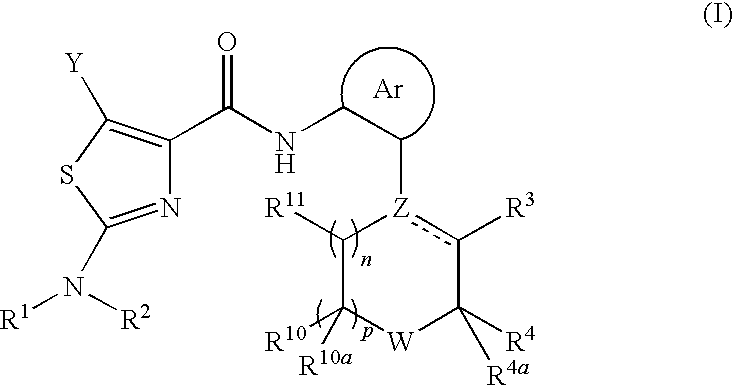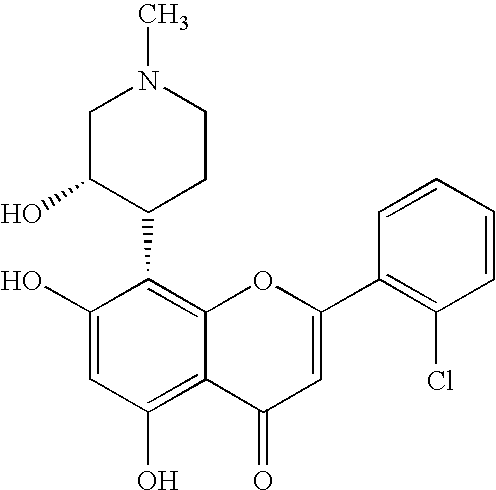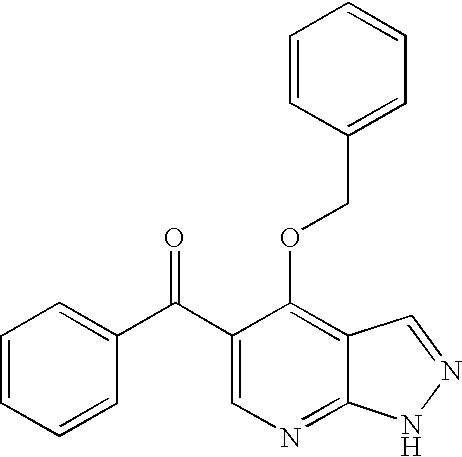2-aminothiazole-4-carboxylic amides as protein kinase inhibitors
a technology of aminothiazole and carboxylic amide, which is applied in the field of anilinopiperazine derivatives, can solve the problems of increased cdk2 activity, poor overall survival, and inducible apoptosis (programmed cell death)
- Summary
- Abstract
- Description
- Claims
- Application Information
AI Technical Summary
Benefits of technology
Problems solved by technology
Method used
Image
Examples
example 1
Preparation of Intermediate Compound A
[0402]
[0403]To a solution of 2-bromo-thiazole-4-carboxylic acid (2.0 mmol, 0.42 g), N,N-diisopropylethylamine (3.0 mmol, 0.52 mL) and HATU (2.0 mmol, 0.76 g) in DMF (10 mL) was added 4-(2-aminophenyl)-piperazine-1-carboxylic acid tert-butyl ester (2.0 mmol, 0.56 g). The reaction mixture was stirred at 80° C. for 3 h, and then concentrated in vacuo. The resulting residue was purified using flash column chromatography on silica gel (eluent: Hexane:EtOAc (4.5:1)) to provide Compound A as a yellow solid (0.67 g, 72%). 1H NMR (400 MHz, CDCl3) δ 10.38 (s, 1H), 8.49 (dd, J=8.0, 1.2 Hz, 1H), 8.14 (s, 1H), 7.23-7.10 (m, 3H), 3.72 (br s, 4H), 2.89-2.87 (m, 4H), 1.50 (s, 9H). HPLC-MS RT=2.39 min, mass calculated for formula C19H23BrN4O3S 466.07, observed LCMS m / z 467.05 (M+H).
example 2
Preparation of Compound 1
[0404]
[0405]A solution of Compound A (0.050 mmol, 23 mg), N,N-diisopropylethylamine (0.20 mmol, 35 μL) and 2,3-dihydro-1H-pyrrolo[3,4-c]pyridine (0.1 mmol) in DMF (1 mL) was irradiated using microwave for 15 minutes at a temperature of 180° C. The reaction mixture was then concentrated in vacuo, and to the resulting residue was added TFA (0.5 mL). The resulting solution was allowed to stir at room temperature for 10 minutes and was then concentrated in vacuo. The resulting residue was purified using reverse phase HPLC to provide Compound 1.
example 3
Preparation of Compound 2
[0406]
[0407]Using the method described in Example 2 and substituting 6,7-dimethoxy-1,2,3,4-tetrahydro-isoquinoline for 2,3-dihydro-1H-pyrrolo[3,4-c]pyridine, Compound 2 was prepared.
PUM
| Property | Measurement | Unit |
|---|---|---|
| temperature | aaaaa | aaaaa |
| column temperature | aaaaa | aaaaa |
| temperature | aaaaa | aaaaa |
Abstract
Description
Claims
Application Information
 Login to View More
Login to View More - R&D
- Intellectual Property
- Life Sciences
- Materials
- Tech Scout
- Unparalleled Data Quality
- Higher Quality Content
- 60% Fewer Hallucinations
Browse by: Latest US Patents, China's latest patents, Technical Efficacy Thesaurus, Application Domain, Technology Topic, Popular Technical Reports.
© 2025 PatSnap. All rights reserved.Legal|Privacy policy|Modern Slavery Act Transparency Statement|Sitemap|About US| Contact US: help@patsnap.com



